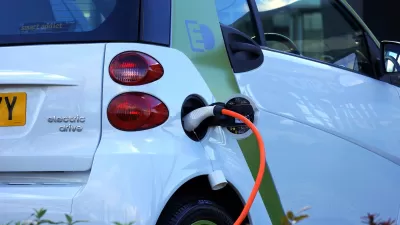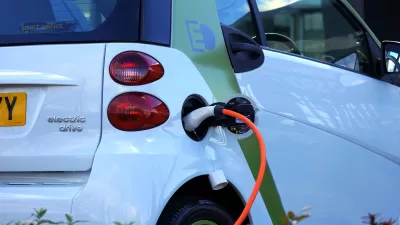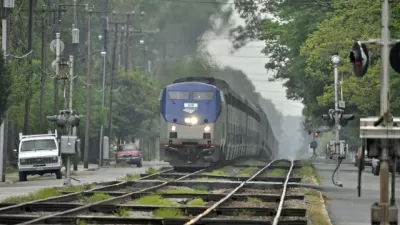The state is poised to gain nearly $1 billion from the federal plan for projects ranging from electric vehicle charging stations to bike lanes and zero-emission bus fleets.

Writing in LA Magazine, Heidi Siegmund Cuda asserts that "California, with the fifth largest economy in the world, stands to gain big—nearly $1 billion—in the current $1 trillion infrastructure plan." But "if the bill is scuttled in the Senate, California could lose about $920 million dedicated to 200 projects." These include:
a dozen bridge repair and construction projects, including a $1 million dollar pedestrian bridge in Wilmington and a bridge safety barrier rail at in Burbank at a cost of $2 million; electric vehicle charging stations for Burbank, Oakland, and San Pedro at about $2.1 million; bike lane expansions and widening in such cities as L.A., North Hollywood, Pasadena, and Camarillo for $6.6 million; and statewide wastewater and drinking water projects; as well as preparing for rising sea levels by shoring up impacted infrastructure.
In Los Angeles, the funding would go toward the Sepulveda Transit Corridor, improvements in the Vermont transit district, bike path improvements, and traffic light upgrades, among other projects. "Zero-emission bus fleets, training, and charging infrastructure are planned for Gardena, Oxnard, Pasadena, San Bernardino, and Wilmington, as part of an $18.2 million investment."
"[U]ltimately, the final bill needs the support of at least ten Senate Republicans as well as that of every Democrat to pass."
FULL STORY: If the Bipartisan Infrastructure Plan Fails, California and L.A. Lose Big

Planetizen Federal Action Tracker
A weekly monitor of how Trump’s orders and actions are impacting planners and planning in America.

Maui's Vacation Rental Debate Turns Ugly
Verbal attacks, misinformation campaigns and fistfights plague a high-stakes debate to convert thousands of vacation rentals into long-term housing.

San Francisco Suspends Traffic Calming Amidst Record Deaths
Citing “a challenging fiscal landscape,” the city will cease the program on the heels of 42 traffic deaths, including 24 pedestrians.

Amtrak Rolls Out New Orleans to Alabama “Mardi Gras” Train
The new service will operate morning and evening departures between Mobile and New Orleans.

The Subversive Car-Free Guide to Trump's Great American Road Trip
Car-free ways to access Chicagoland’s best tourist attractions.

San Antonio and Austin are Fusing Into one Massive Megaregion
The region spanning the two central Texas cities is growing fast, posing challenges for local infrastructure and water supplies.
Urban Design for Planners 1: Software Tools
This six-course series explores essential urban design concepts using open source software and equips planners with the tools they need to participate fully in the urban design process.
Planning for Universal Design
Learn the tools for implementing Universal Design in planning regulations.
Heyer Gruel & Associates PA
JM Goldson LLC
Custer County Colorado
City of Camden Redevelopment Agency
City of Astoria
Transportation Research & Education Center (TREC) at Portland State University
Jefferson Parish Government
Camden Redevelopment Agency
City of Claremont





























